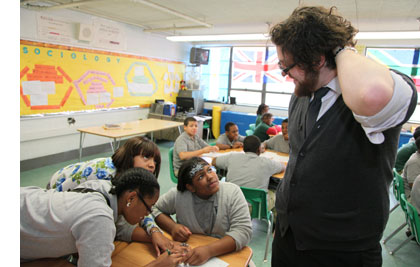FINDING LIGHT - PART II
Working the Baltimore gap

Robbie Earle '05
is
proving inner-city kids learn as well
as suburban kids
Cherry Hill Elementary and the community of Cherry Hill lie less than three miles southeast of historic Fort McHenry and about the same distance south of Baltimore's shiny Inner Harbor.
But, cut off from most of the city by waterways, highways, and railroad tracks, this once proud African-American community has been decaying for nearly half of its 57-year existence.
"I've been teaching at Cherry Hill Elementary for four years," said Ronald Spruill, a 60-year-old math teacher and veteran of both Baltimore City and Baltimore County schools. "In that time, a student was murdered (shot eight times) and another was accused in a gang rape."
"On one occasion," he added, "I had to grab children when gunfire rang out on the playground."
"Still it also is a tight-knit, family-centered community," he insisted. "You will see fathers walking their children to school."
Seventy-percent of the students qualify for free or reduced-price lunch programs. Test scores rank at the bottom of Baltimore's public schools.
In the fall of 2009, Robbie Earle '05 was just another in a long line of Teach for America recruits who was learning how hard it is to give low-income children a chance at a good education.
(This year, 8,200 Teach for America "corps members" are teaching 500,000 low-income children in 39 urban and rural regions.)
"Students physically accosted teachers," he explained. "The psychological stress was enormous."
"There were days driving to Cherry Hill," Earle admitted, "when I almost hoped I'd run out of gas or have a flat tire, just so I wouldn't have to face it."

